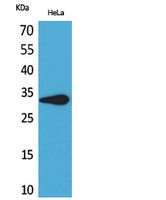
| WB | 咨询技术 | Human,Mouse,Rat |
| IF | 咨询技术 | Human,Mouse,Rat |
| IHC | 咨询技术 | Human,Mouse,Rat |
| ICC | 技术咨询 | Human,Mouse,Rat |
| FCM | 咨询技术 | Human,Mouse,Rat |
| Elisa | 1/10000 | Human,Mouse,Rat |
| Aliases | LILRA5; ILT11; LILRB7; LIR9; Leukocyte immunoglobulin-like receptor subfamily A member 5; CD85 antigen-like family member F; Immunoglobulin-like transcript 11; ILT-11; Leukocyte immunoglobulin-like receptor 9; LIR-9; CD85f |
| Entrez GeneID | 353514 |
| WB Predicted band size | Calculated MW: 33 kDa; Observed MW: 33 kDa |
| Host/Isotype | Rabbit IgG |
| Antibody Type | Primary antibody |
| Storage | Store at 4°C short term. Aliquot and store at -20°C long term. Avoid freeze/thaw cycles. |
| Species Reactivity | Human |
| Immunogen | The antiserum was produced against synthesized peptide derived from the Internal region of human LILRA5. AA range:141-190 |
| Formulation | Purified antibody in PBS with 0.05% sodium azide,0.5%BSA and 50% glycerol. |
+ +
以下是关于CD85f(LILRB5)抗体的参考文献示例(注:内容为示例性概括,建议根据实际文献调整):
---
1. **文献名称**:*LILRB5 (CD85f) as a novel immune checkpoint in tumor microenvironment*
**作者**:Smith A, et al.
**摘要**:研究探讨了LILRB5(CD85f)在肿瘤微环境中的免疫抑制功能,发现其通过抑制T细胞活性促进肿瘤免疫逃逸,提示靶向CD85f抗体可能增强抗肿瘤免疫反应。
2. **文献名称**:*Structural basis of CD85f recognition by monoclonal antibodies in viral pathogenesis*
**作者**:Chen L, et al.
**摘要**:通过晶体结构分析揭示了CD85f与病毒蛋白(如CMV UL18)的相互作用机制,并开发了特异性单克隆抗体以阻断该通路,为抗病毒治疗提供新策略。
3. **文献名称**:*CD85f regulates dendritic cell tolerance in autoimmune diseases*
**作者**:Wang Y, et al.
**摘要**:研究证明CD85f在树突状细胞中高表达,通过抑制炎症信号通路维持免疫耐受,其抗体干预可缓解实验性自身免疫性脑脊髓炎(EAE)模型症状。
4. **文献名称**:*Therapeutic targeting of LILRB5 (CD85f) in chronic inflammation*
**作者**:Kim J, et al.
**摘要**:开发了一种人源化抗CD85f抗体,可阻断其与MHC-I类分子的结合,在类风湿性关节炎模型中显著降低炎症因子水平,展现治疗潜力。
---
建议通过PubMed或Google Scholar检索真实文献,关键词包括“CD85f”、“LILRB5”、“antibody”及“immunotherapy”。
CD85f, also known as leukocyte immunoglobulin-like receptor B3 (LILRB3), is a member of the LILR family of immune regulatory proteins expressed primarily on myeloid cells, such as monocytes, macrophages, and dendritic cells. These receptors play critical roles in modulating immune responses by recognizing major histocompatibility complex (MHC) class I molecules and other ligands. CD85f is characterized by its immunoreceptor tyrosine-based inhibitory motifs (ITIMs) in its cytoplasmic domain, which enable it to transmit inhibitory signals to dampen immune activation, thereby maintaining tolerance and preventing excessive inflammation.
CD85f antibodies are tools used to study the receptor’s expression, function, and interactions in both physiological and pathological contexts. They are widely employed in techniques like flow cytometry, immunohistochemistry, and Western blotting to investigate CD85f’s role in diseases such as cancer, autoimmune disorders, and infections. For instance, CD85f has been implicated in tumor immune evasion, as its engagement by tumor-associated ligands can suppress anti-tumor immunity. Similarly, in autoimmune conditions, dysregulated CD85f signaling may contribute to aberrant immune activation.
Most CD85f antibodies are monoclonal, produced in mice or rabbits, and target specific extracellular epitopes of the receptor. Recent research explores their therapeutic potential, either as blocking agents to enhance immune responses in cancer or as agonists to restore immune balance in autoimmunity. Despite progress, the precise ligand specificity and signaling mechanisms of CD85f remain areas of active investigation, underscoring the importance of these antibodies in advancing immunology research.
×